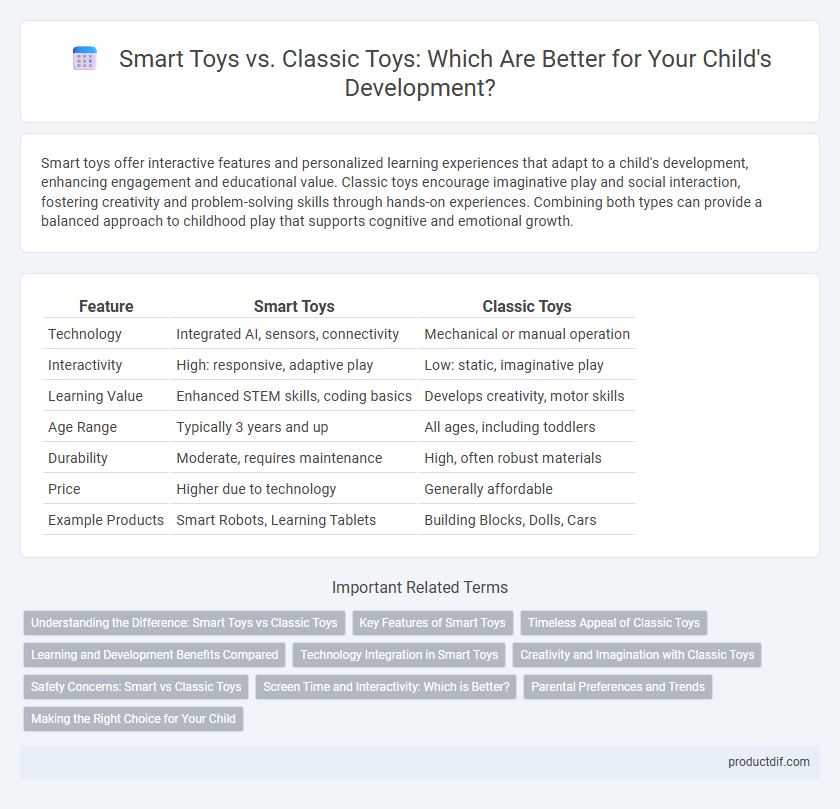Smart toys offer interactive features and personalized learning experiences that adapt to a child's development, enhancing engagement and educational value. Classic toys encourage imaginative play and social interaction, fostering creativity and problem-solving skills through hands-on experiences. Combining both types can provide a balanced approach to childhood play that supports cognitive and emotional growth.
Table of Comparison
| Feature | Smart Toys | Classic Toys |
|---|---|---|
| Technology | Integrated AI, sensors, connectivity | Mechanical or manual operation |
| Interactivity | High: responsive, adaptive play | Low: static, imaginative play |
| Learning Value | Enhanced STEM skills, coding basics | Develops creativity, motor skills |
| Age Range | Typically 3 years and up | All ages, including toddlers |
| Durability | Moderate, requires maintenance | High, often robust materials |
| Price | Higher due to technology | Generally affordable |
| Example Products | Smart Robots, Learning Tablets | Building Blocks, Dolls, Cars |
Understanding the Difference: Smart Toys vs Classic Toys
Smart toys incorporate advanced technologies such as AI, sensors, and connectivity to provide interactive and adaptive play experiences that can enhance learning and creativity. Classic toys, by contrast, rely on physical manipulation and imaginative play without digital components, fostering tactile skills and social interaction through simplicity. Understanding the difference helps parents choose toys that align with developmental goals and technological engagement preferences.
Key Features of Smart Toys
Smart toys integrate advanced technologies such as artificial intelligence, sensors, and connectivity to offer interactive and adaptive play experiences. They provide features like voice recognition, educational content, and real-time feedback, enhancing cognitive development and personalized learning. Unlike classic toys, smart toys can evolve through software updates, ensuring sustained engagement and skill advancement.
Timeless Appeal of Classic Toys
Classic toys such as wooden blocks, dolls, and puzzles have maintained their timeless appeal due to their simplicity, durability, and ability to stimulate creativity and imagination in children. Unlike smart toys that rely heavily on technology and batteries, classic toys encourage hands-on play and foster cognitive development through tactile engagement and problem-solving. This enduring charm makes classic toys a cherished choice for generations, valued for their educational benefits and ability to nurture fundamental skills without technological dependency.
Learning and Development Benefits Compared
Smart toys integrate advanced technologies like AI and interactive sensors to offer personalized learning experiences, enhancing cognitive, motor, and social skills more effectively than classic toys. Classic toys foster creativity and imaginative play through open-ended design but may lack adaptive feedback and real-time skill assessment found in smart toys. Studies reveal that smart toys can accelerate language acquisition and problem-solving abilities, while classic toys promote long-term imaginative development and emotional regulation.
Technology Integration in Smart Toys
Smart toys leverage advanced technologies such as artificial intelligence, sensors, and connectivity to provide interactive and adaptive play experiences that classic toys lack. Embedded AI allows smart toys to recognize speech, respond to emotions, and customize activities, enhancing learning and engagement for children. Integration with mobile apps and the Internet of Things (IoT) enables remote control and continuous updates, making smart toys more versatile and dynamic than traditional toys.
Creativity and Imagination with Classic Toys
Classic toys like building blocks, wooden puzzles, and art supplies foster creativity and imagination by encouraging open-ended play without preset instructions or screens. These toys stimulate cognitive development as children invent stories, experiment with structures, and explore tactile materials, enhancing problem-solving skills and innovative thinking. Unlike smart toys that often guide play with interactive features, classic toys promote independent creativity and free expression through hands-on engagement.
Safety Concerns: Smart vs Classic Toys
Smart toys often raise safety concerns due to their connectivity features, which can expose children to privacy risks and data breaches. Classic toys, made from traditional materials without electronic components, typically pose fewer safety hazards related to cyber threats but may have physical risks such as choking hazards. Parents seeking safe play options should weigh the digital vulnerabilities of smart toys against the tangible safety factors of classic toys.
Screen Time and Interactivity: Which is Better?
Smart toys enhance interactivity through programmable features and app integration, promoting cognitive skills while often increasing screen time exposure. Classic toys encourage imaginative play and physical manipulation without screens, supporting fine motor skills and creativity without digital distractions. Balancing screen time and hands-on engagement is crucial to optimizing developmental benefits in children's play experiences.
Parental Preferences and Trends
Parental preferences increasingly favor smart toys for their educational value, interactive features, and ability to adapt to a child's developmental needs, enhancing learning through technology. Classic toys maintain appeal due to their simplicity, durability, and the fostering of imaginative play without screens or batteries, often preferred by parents seeking to limit digital exposure. Current trends reveal a growing market for hybrid toys that combine traditional tactile elements with embedded smart technology, merging the benefits of both categories.
Making the Right Choice for Your Child
Smart toys incorporate advanced technologies like AI and interactive features to enhance learning and engagement, making them ideal for fostering cognitive development in children. Classic toys offer timeless appeal through imaginative play and simplicity, promoting creativity and social skills without digital distractions. Choosing the right toy depends on your child's interests, developmental needs, and the balance between screen time and hands-on interaction.
Smart toys vs classic toys Infographic

 productdif.com
productdif.com